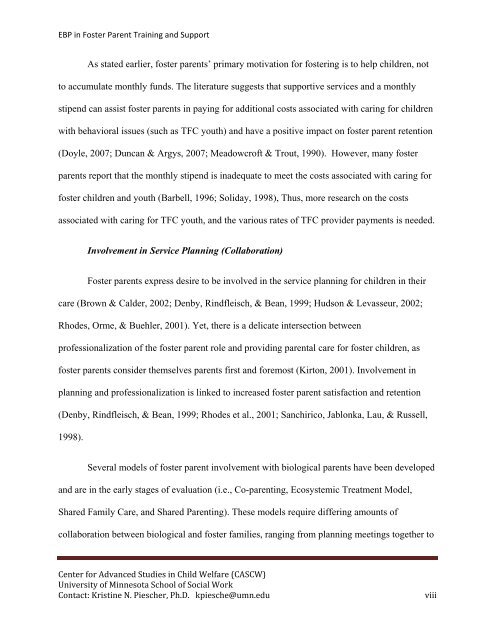Evidence-Based Practice in Foster Parent Training and Support ...
Evidence-Based Practice in Foster Parent Training and Support ...
Evidence-Based Practice in Foster Parent Training and Support ...
You also want an ePaper? Increase the reach of your titles
YUMPU automatically turns print PDFs into web optimized ePapers that Google loves.
EBP <strong>in</strong> <strong>Foster</strong> <strong>Parent</strong> Tra<strong>in</strong><strong>in</strong>g <strong>and</strong> <strong>Support</strong>As stated earlier, foster parents’ primary motivation for foster<strong>in</strong>g is to help children, notto accumulate monthly funds. The literature suggests that supportive services <strong>and</strong> a monthlystipend can assist foster parents <strong>in</strong> pay<strong>in</strong>g for additional costs associated with car<strong>in</strong>g for childrenwith behavioral issues (such as TFC youth) <strong>and</strong> have a positive impact on foster parent retention(Doyle, 2007; Duncan & Argys, 2007; Meadowcroft & Trout, 1990). However, many fosterparents report that the monthly stipend is <strong>in</strong>adequate to meet the costs associated with car<strong>in</strong>g forfoster children <strong>and</strong> youth (Barbell, 1996; Soliday, 1998), Thus, more research on the costsassociated with car<strong>in</strong>g for TFC youth, <strong>and</strong> the various rates of TFC provider payments is needed.Involvement <strong>in</strong> Service Plann<strong>in</strong>g (Collaboration)<strong>Foster</strong> parents express desire to be <strong>in</strong>volved <strong>in</strong> the service plann<strong>in</strong>g for children <strong>in</strong> theircare (Brown & Calder, 2002; Denby, R<strong>in</strong>dfleisch, & Bean, 1999; Hudson & Levasseur, 2002;Rhodes, Orme, & Buehler, 2001). Yet, there is a delicate <strong>in</strong>tersection betweenprofessionalization of the foster parent role <strong>and</strong> provid<strong>in</strong>g parental care for foster children, asfoster parents consider themselves parents first <strong>and</strong> foremost (Kirton, 2001). Involvement <strong>in</strong>plann<strong>in</strong>g <strong>and</strong> professionalization is l<strong>in</strong>ked to <strong>in</strong>creased foster parent satisfaction <strong>and</strong> retention(Denby, R<strong>in</strong>dfleisch, & Bean, 1999; Rhodes et al., 2001; Sanchirico, Jablonka, Lau, & Russell,1998).Several models of foster parent <strong>in</strong>volvement with biological parents have been developed<strong>and</strong> are <strong>in</strong> the early stages of evaluation (i.e., Co-parent<strong>in</strong>g, Ecosystemic Treatment Model,Shared Family Care, <strong>and</strong> Shared <strong>Parent</strong><strong>in</strong>g). These models require differ<strong>in</strong>g amounts ofcollaboration between biological <strong>and</strong> foster families, rang<strong>in</strong>g from plann<strong>in</strong>g meet<strong>in</strong>gs together toCenter for Advanced Studies <strong>in</strong> Child Welfare (CASCW)University of M<strong>in</strong>nesota School of Social WorkContact: Krist<strong>in</strong>e N. Piescher, Ph.D. kpiesche@umn.eduviii
















